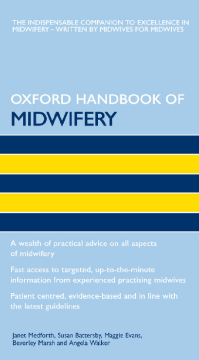
BOOK
Oxford Handbook of Midwifery
Janet Medforth | Sue Battersby | Maggie Evans | Beverly Marsh | Angela Walker
(2006)
Additional Information
Book Details
Abstract
The Oxford Handbook of Midwifery is the first pocket-sized handbook to provide midwives with everything they need for successful practice. It contains concise, practical and expert guidance on all aspects of the midwife's role, from pre-conceptual advice to the final postnatal examination of the mother and baby. Giving a complete picture of the role of the midwife, the handbook's contents reflect the mother's journey through conception, pregnancy and birth. Helping you achieve the best possible results for your patients, the authors offer a wealth of recommendations, guidance and information from their years of experience. Whatever situation you are in, the Oxford Handbook of Midwifery will give you the information you need. The handbook covers the vast majority of scenarios you will ever encounter. The fundamentals of midwifery are divided into five main sections, covering antenatal care; normal labour and birth; complicated labour and birth; infant feeding and postnatal care. The handbook also gives information rarely covered in standard midwifery texts, including sexual health, complementary therapies, common blood values, investigations, and midwifery emergencies. Key interventions are laid out as algorithms to aid quick assimilation of the crucial facts. So you can find the information you need without delay, the book is clearly laid out with one topic per page, and written in an easily readable note-based style. Blank pages for writing notes, observations and local protocols allow your handbook to be customised to meet your specific needs. All this is available at your fingertips, in a pocket-sized handbook with hard-wearing plastic covers. Written by practising midwives and checked by subject experts, the Oxford Handbook of Midwifery is a unique and invaluable companion to practising and student midwives, lecturers, and to all those who need to understand the special issues associated with midwifery practise.
